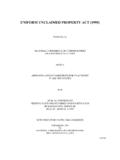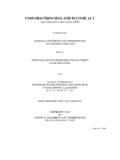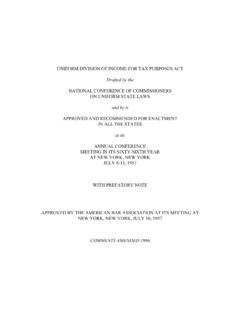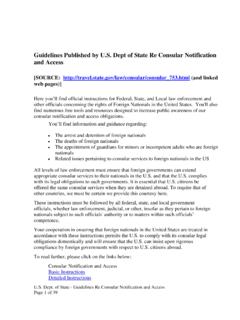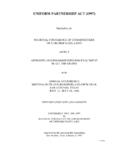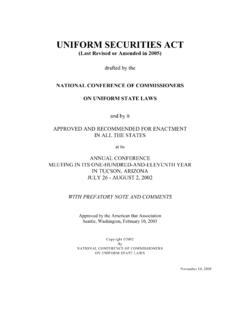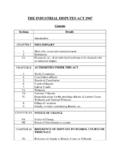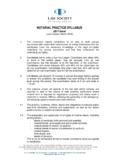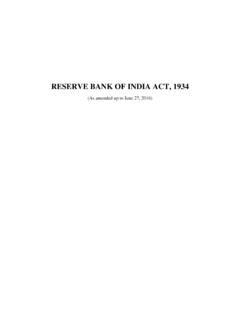Transcription of UNIFORM TRANSFERS TO MINORS ACT (Last …
1 UNIFORM TRANSFERS TO MINORS ACT. (Last Revised or Amended 1986). Drafted by the national CONFERENCE OF COMMISSIONERS. ON UNIFORM STATE LAWS. and by it APPROVED AND RECOMMENDED FOR ENACTMENT. IN ALL THE STATES. at its ANNUAL CONFERENCE. MEETING IN ITS NINETY-SECOND YEAR. IN BOCA RATON, FLORIDA. JULY 22-29, 1983. With Prefatory Note and Comments UNIFORM TRANSFERS TO MINORS ACT. The Committee that acted for the national Conference of Commissioners on UNIFORM State Laws in preparing the UNIFORM TRANSFERS to MINORS Act was as follows: LAWRENCE J. BUGGE, Box 1497, Madison, WI 53701, Chairman CHARLES M. CROOK, 2 Dexter Avenue, Montgomery, AL 36104. DIANA S. DOWLING, Room 138, State Capitol, Helena, MT 59620. THOMAS L. JONES, 5557, University, AL 35486. CHARLES G. KEPLER, Box 490, Cody, WY 82414. BROCKENBROUGH LAMB, JR., 1200 Mutual Building, Richmond, VA 23219. ROBERT C. ROBINSON, Box 568, Portland, ME 04112. THOMAS A.
2 SHIELS, Legislative Council, Legislative Hall, Dover, DE 19901. M. KING HILL, JR., Sixth Floor, 100 Light Street, Baltimore, MD 21202, President (Member Ex Officio). CARLYLE C. RING, JR., 710 Ring Building, Washington, DC 20036, Chairman, Executive Committee WILLIAM J. PIERCE, University of Michigan, School of Law, Ann Arbor, MI 48109, Executive Director ELMER R. OETTINGER, 58 Oakwood Drive, Chapel Hill, NC 27514, Chairman, Division F. (Member Ex Officio). Review Committee CHARLES M. WELLING, Box 33544, Charlotte, NC 28233, Chairman MARION W. BENFIELD, JR., University of Illinois, College of Law, Champaign, IL 61820. LANI LIU EWART, 1600 Castle & Cooke Building, Honolulu, HI 96813. Advisor to Special Committee on UNIFORM TRANSFERS to MINORS Act EDWARD B. BENJAMIN, JR., American Bar Association Final, approved copies of this Act and copies of all UNIFORM and Model Acts issued by the Conference may be obtained from: national CONFERENCE OF COMMISSIONERS.
3 ON UNIFORM STATE LAWS. 645 North Michigan Avenue, Suite 510. Chicago, Illinois 60611. (312) 321-9710. 2. UNIFORM TRANSFERS TO MINORS ACT. PREFATORY NOTE. This Act revises and restates the UNIFORM Gifts to MINORS Act (UGMA), one of the Conference's most successful products, some version of which has been enacted in every American jurisdiction. The original version of UGMA was adopted by the Conference in 1956 and closely followed a model "Act concerning Gifts of Securities to MINORS " which was sponsored by the New York Stock Exchange and the Association of Stock Exchange Firms and which had been adopted in 14 states. The 1956 version of UGMA broadened the model act to cover gifts of money as well as securities but made few other changes. In 1965 and 1966 the Conference revised UGMA to expand the types of financial institutions which could serve as depositories of custodial funds, to facilitate the designation of successor custodians, and to add life insurance policies and annuity contracts to the types of property (cash and securities) that could be made the subject of a gift under the Act.
4 Not all states adopted the 1966 revisions; some 11 jurisdictions retained their versions of the 1956 Act. More importantly, however, many states since 1966 have substantially revised their versions of UGMA to expand the kinds of property that may be made the subject of a gift under the Act, and a few states permit TRANSFERS to custodians from other sources, such as trusts and estates, as well as lifetime gifts. As a result, a great deal of non-uniformity has arisen among the states. Uniformity in this area is important, for the Conference has cited UGMA as an example of an act designed to avoid conflicts of law when the laws of more than one state may apply to a transaction or a series of transactions. This Act follows the expansive approach taken by several states and allows any kind of property, real or personal, tangible or intangible, to be made the subject of a transfer to a custodian for the benefit of a minor (SECTION 1(6)).
5 In addition, it permits such TRANSFERS not only by lifetime outright gifts (SECTION 4), but also from trusts, estates and guardianships, whether or not specifically authorized in the governing instrument (SECTIONS 5 and 6), and from other third parties indebted to a minor who does not have a conservator, such as parties against whom a minor has a tort claim or judgment, and depository institutions holding deposits or insurance companies issuing policies payable on death to a minor (SECTION 7). For this reason, and to distinguish the enactment of this statute from the 1956 and 1966 versions of UGMA, the title of the Act has been changed to refer to " TRANSFERS " rather than to "Gifts," a much narrower term. As so expanded, the Act might be considered a statutory form of trust or guardianship that continues until the minor reaches 21. Note, however, that unlike a trust, a custodianship is not a separate legal entity or taxpayer.
6 Under SECTION 11(b) of this Act, the custodial property is 3. indefeasibly vested in the minor , not the custodian, and thus any income received is attributable to and reportable by the minor , whether or not actually distributed to the minor . The expansion of the Act to permit TRANSFERS of any kind of property to a custodian creates a significant problem of potential personal liability for the minor or the custodian arising from the ownership of property such as real estate, automobiles, general partnership interests, and business proprietorships. This problem did not exist under UGMA under which custodial property was limited to bank deposits, securities and insurance. In response, SECTION 17 of this Act generally limits the claims of third parties to recourse against the custodial property, with the minor insulated against personal liability unless he is personally at fault. The custodian is similarly insulated unless he is personally at fault or fails to disclose his custodial capacity in entering into a contract.
7 Nevertheless, the Act should be used with caution with respect to property such as real estate or general partnership interests from which liabilities as well as benefits may arise. Many of the possible risks can and should be insured against, and the custodian has the power under SECTION 13(a) to purchase such insurance, at least when other custodial assets are sufficient to do so. If the assets are not sufficient, there is doubt that a custodian will act, or there are significant uninsurable risks, a transferor should consider a trust with spendthrift provisions, such as a minority trust under Section 2503(c), IRC, rather than a custodianship, to make a gift of such property to a minor . The Act retains (or reverts to) 21 as the age of majority or, more accurately, the age at which the custodianship terminates and the property is distributed. Since tax law permits duration of Section 2503(c) trusts to 21, even though the statutory age of majority is 18 in most states, this age should be retained since most donors and other transferors wish to preserve a custodianship as long as possible.
8 Finally, the Act restates and rearranges, rather than amends, the 1966 Act. The addition of other forms of property and other forms of dispositions made adherence to the format and language of the prior act very unwieldy. In addition, the 1966 and 1956 Acts closely followed the language of the earlier model act, which had already been adopted in several states, even though it did not conform to Conference style. It is hoped that this rewriting and revision of UGMA will improve its clarity while also expanding its coverage. 4. UNIFORM TRANSFERS TO MINORS ACT. SECTION 1. DEFINITIONS. In this [Act]: (1) "Adult" means an individual who has attained the age of 21 years. (2) "Benefit plan" means an employer's plan for the benefit of an employee or partner. (3) "Broker" means a person lawfully engaged in the business of effecting transactions in securities or commodities for the person's own account or for the account of others.
9 (4) "Conservator" means a person appointed or qualified by a court to act as general, limited, or temporary guardian of a minor 's property or a person legally authorized to perform substantially the same functions. (5) "Court" means [_____ court]. (6) "Custodial property" means (i) any interest in property transferred to a custodian under this [Act] and (ii) the income from and proceeds of that interest in property. (7) "Custodian" means a person so designated under Section 9 or a successor or substitute custodian designated under Section 18. (8) "Financial institution" means a bank, trust company, savings institution, or credit union, chartered and supervised under state or federal law. (9) "Legal representative" means an individual's personal representative or conservator. (10) "Member of the minor 's family" means the minor 's parent, stepparent, spouse, 5. grandparent, brother, sister, uncle, or aunt, whether of the whole or half blood or by adoption.
10 (11) " minor " means an individual who has not attained the age of 21 years. (12) "Person" means an individual, corporation, organization, or other legal entity. (13) "Personal representative" means an executor, administrator, successor personal representative, or special administrator of a decedent's estate or a person legally authorized to perform substantially the same functions. (14) "State" includes any state of the United States, the District of Columbia, the Commonwealth of Puerto Rico, and any territory or possession subject to the legislative authority of the United States. (15) " transfer " means a transaction that creates custodial property under Section 9. (16) "Transferor" means a person who makes a transfer under this [Act]. (17) "Trust company" means a financial institution, corporation, or other legal entity, authorized to exercise general trust powers. COMMENT. To reflect the broader scope and the unlimited types of property to which the new Act will apply, a number of definitional changes have been made from the 1966 Act.
